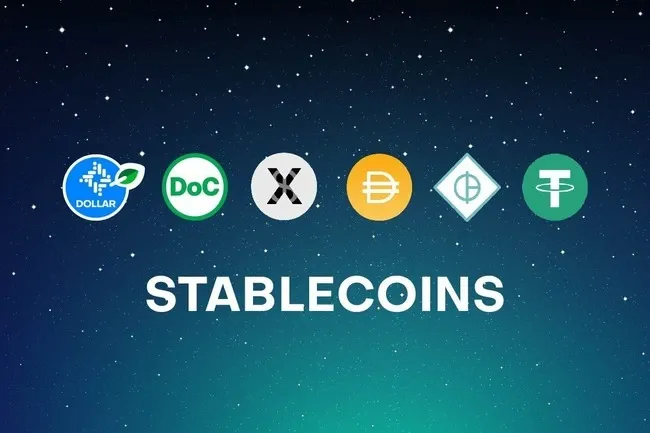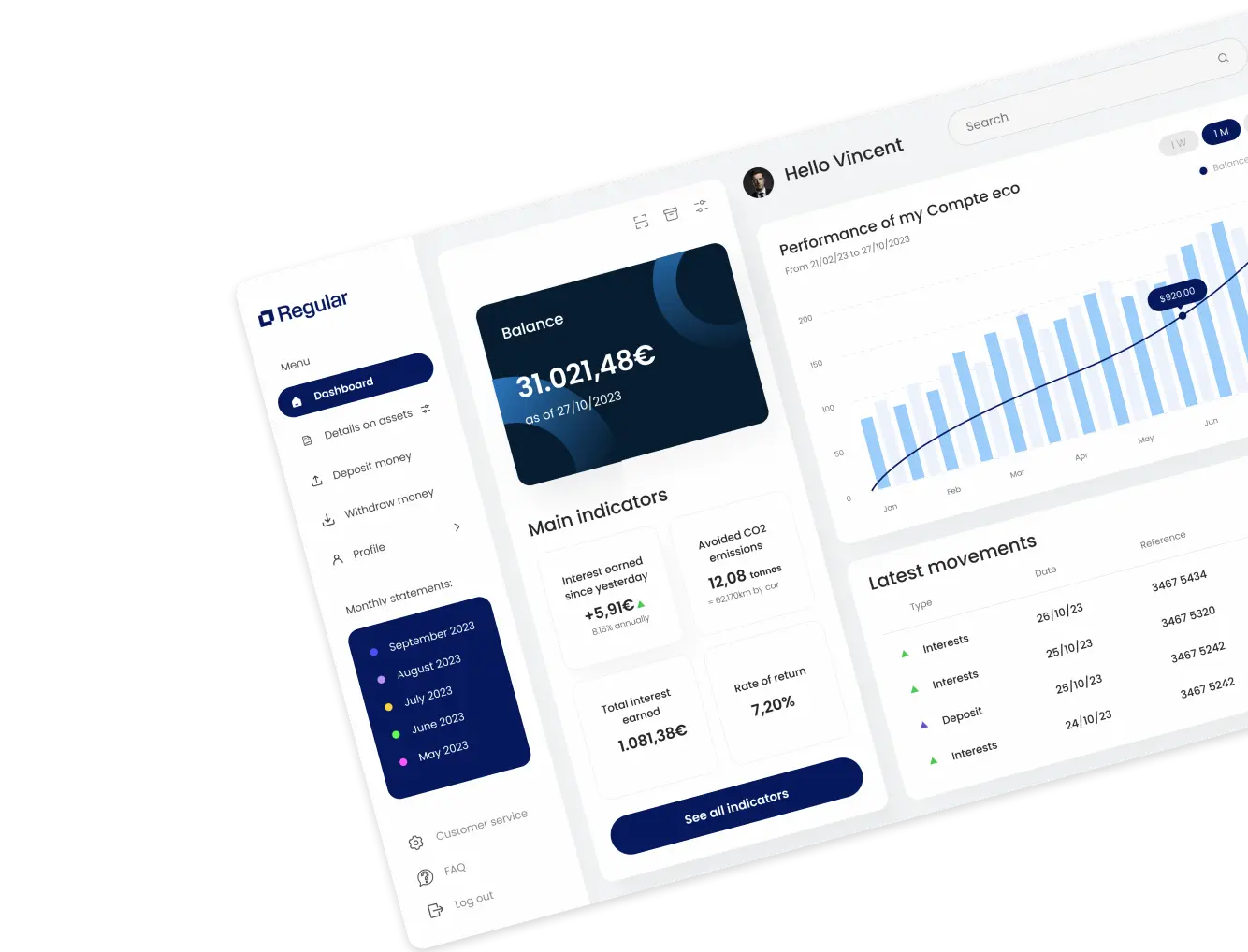Corporate cash management is no longer just about prudence — it’s now a lever for efficiency and performance, even in the short term.
In 2025, the economic landscape is reshaping how companies manage their excess liquidity: interest rates are once again attractive, inflation remains persistent, and regulation is becoming stricter in a digitalized environment.
Business leaders are now looking to grow their surplus cash without freezing their liquidity, by combining security, availability, and performance.
That’s the challenge — and the opportunity — of short-term corporate investing: making idle funds productive for just a few months, while keeping full operational flexibility.
In this article, we’ll review the best short-term investment options for companies — from term deposits and money-market funds to regulated stablecoins, a new high-performance alternative fully aligned with European standards.
Article summary
In 2025, short-term investing becomes a true strategic lever for businesses.
It allows companies to grow their cash without immobilizing it, through secure and flexible solutions.
Between term deposits, money-market funds, and regulated stablecoins, success lies in balancing liquidity, moderate yield, and compliance — all within a clear European framework under MiCA.
Understanding Short-Term Corporate Investments

Definition and investment horizon
A short-term investment refers to any placement with a lock-up period of less than 24 months — typically between 1 and 12 months for most businesses.
Its purpose is not speculation or the pursuit of high returns, but rather the temporary enhancement of excess liquidity without sacrificing accessibility.
In practice, this means putting surplus cash — generated from a healthy operating cycle — to work while waiting for an upcoming investment project, tax payment, or strategic expense.
Short-term placements are built on three fundamental pillars:
- Security: capital preservation above all else.
- Liquidity: the ability to access funds quickly, without penalties.
- Return: aiming for a moderate yield, higher than a dormant current account.
Why short-term investing becomes strategic again in 2025
After years of near-zero interest rates, the lasting return of positive yields has reignited corporate interest in short-term placements.
In 2025, well-managed liquidity can generate 3% to 6% annual returns, all while remaining fully accessible.
Companies are rediscovering the short term as a true management tool:
- It optimizes idle capital without locking it up.
- It helps offset inflationary pressure.
- It reduces the opportunity cost of inactive cash.
Finance departments are adopting a more proactive stance: treasury is no longer just a safety buffer — it’s a performance driver.
💡 Key takeaway
Idle cash creates a double loss:
- a loss of purchasing power due to inflation,
- and a loss of potential yield in a favorable market environment.
Even simple short-term placements — such as interest-bearing accounts, money-market funds, or regulated stablecoins — can now turn passive cash into an active financial resource.
Traditional Short-Term Investment Solutions
Term deposits (CAT)
The term deposit remains one of the most popular tools for optimizing corporate cash over a short period.
It involves locking in a fixed amount of money for a defined duration — usually between 1 and 24 months — in exchange for a guaranteed interest rate set at the time of subscription.
Advantages:
- Guaranteed capital and returns from the bank.
- Full visibility on duration and profitability.
- No market exposure or daily management required.
Limitations:
- Funds are locked until maturity (early withdrawal may trigger penalties).
- Returns may lag behind more dynamic options if interest rates rise.
Ideal for SMEs seeking stability and predictability, especially for clearly identified short-term surpluses.
Professional interest-bearing accounts
Interest-bearing current accounts allow companies to earn a return on idle cash without losing liquidity.
The interest rate depends on the bank and the balance level, with daily interest accrual.
Advantages:
- No fund lock-up period.
- Interest paid regularly (often monthly).
- Easy management, integrated into daily treasury operations.
Points of attention:
- Typically lower yields than term deposits.
- Sometimes subject to minimum balance requirements or account maintenance fees.
Suitable for companies requiring full flexibility, while offsetting the cost of idle cash.
Dynamic money-market funds
Money-market funds invest in very short-term financial instruments (Treasury bills, sovereign debt, certificates of deposit).
They are designed to preserve capital while taking advantage of market rate movements.
Advantages:
- Near-instant liquidity (redemption possible at any time).
- Often higher returns than savings accounts or short-term term deposits.
- Professional management and built-in diversification.
Drawbacks:
- Very low but not zero risk (linked to the fund’s net asset value).
- Management fees may be higher than for traditional bank products.
In 2025, money-market funds offer average annual returns of 3% to 4.5%, depending on their risk profile and exposure to European short-term rates.
Summary – Traditional short-term banking products
| Product Type | Average Yield (2025) | Liquidity | Risk | Best For |
| Term deposit (CAT) | 3–4.5% | Locked until maturity | Low | Stable short-term surpluses |
| Interest-bearing account | 2–3% | Immediate | None to low | Constant liquidity needs |
| Dynamic money-market fund | 3–4.5% | T+1 or T+2 | Low | Optimized management without lock-up |
These instruments form the foundation of prudent treasury management.
To go further, companies can now combine traditional products with regulated digital assets, offering greater flexibility and improved yields.
Regulated Stablecoins: The New Generation of Short-Term Investments

Definition and how regulated stablecoins work
A regulated stablecoin is a digital asset backed by a fiat currency (such as the euro or dollar), issued by a licensed and supervised financial institution.
Its goal: to mirror the stability of traditional money while providing the instant liquidity and transparency enabled by blockchain technology.
In practice, each token (for example, 1 EURC = €1) is fully collateralized by equivalent reserves held in secure, segregated bank accounts.
Companies can allocate part of their treasury to these instruments through MiCA-compliant intermediaries, earning stablecoins yields generated from the management of underlying reserves — typically between 3% and 6%, depending on the provider and duration.
Why companies are adopting them
Regulated stablecoins offer a new balance between security, yield, and liquidity.
For CFOs and finance teams, they meet several key objectives:
- Optimize surplus cash without locking it up.
- Access higher returns than traditional bank products.
- Enable instant intercompany transfers within groups or subsidiaries.
- Gain full transparency over cash flows and reserve backing.
In 2025, adoption is growing rapidly — particularly among innovative SMEs and European holding companies — as stablecoins become a complementary building block in modern short-term investment strategies.
Regulatory framework and security (MiCA, transparency, compliance)
Since 2024, the MiCA Regulation (Markets in Crypto-Assets) has set a unified legal framework for stablecoins across the European Union.
It imposes strict rules on issuers and platforms, including:
- Mandatory EU authorization to operate.
- Regular independent audits of reserve holdings.
- Full segregation between corporate funds and client assets.
- Monthly transparency reports detailing reserves and circulation.
These measures ensure a level of protection comparable — or superior — to traditional banking products, while providing instant (T+0) liquidity and complete transaction traceability.
Comparison – Term deposit / Interest-bearing account / Regulated stablecoin
| Criterion | Term Deposit (CAT) | Interest-Bearing Account | Regulated Stablecoin |
| Average Yield (2025) | 3–4.5% | 2–3% | 4–6% |
| Availability | Locked until maturity | Immediate | Instant (T+0) |
| Risk | Very low | None to low | Low (MiCA-compliant only) |
| Transparency | Moderate | Moderate | Full (blockchain + audited reserves) |
| Access | Via bank | Via bank | Via EU-regulated platform |
💡 Key takeaway
Regulated stablecoins are becoming the new standard for short-term investing:
- as liquid as a professional current account,
- as stable and supervised as a traditional bank product,
- yet more efficient and higher-yielding, powered by a modern European financial infrastructure.
Building an Effective Short-Term Investment Strategy
Identifying the investable portion of cash
Before making any investment decision, it’s essential to quantify the exact amount of available liquidity.
A company’s treasury should be broken down into three distinct categories:
- Operating cash: covers salaries, suppliers, and recurring expenses.
- Contingency cash: represents 2 to 3 months of advance expenses.
- Investable surplus: excess liquidity that can be placed without affecting operational stability.
A simple approach is to follow the “three-pocket rule”:
- Operational pocket → immediate liquidity, uninvested.
- Security pocket → very short-term placement (term deposits, interest-bearing accounts).
- Yield pocket → optimized allocation (money-market funds, regulated stablecoins).
Segmenting treasury by time horizon and objective
A high-performing short-term strategy relies on clear segmentation — each time horizon must serve a specific financial purpose.
| Horizon | Primary Objective | Suitable Instruments |
| 0–3 months | Maximum availability | Interest-bearing accounts, regulated stablecoins |
| 3–12 months | Security + moderate yield | Term deposits, money-market funds |
| 12–24 months | Yield optimization | Bond funds or dynamic placements |
This structure combines performance and flexibility, reducing the risk of liquidity constraints.
Monitoring and adjusting regularly
Once established, the strategy should be actively managed.
Interest rates, liquidity needs, and regulations evolve quickly:
- Review your allocation every 3 to 6 months.
- Evaluate overall yield and liquidity share.
- Adjust according to context — rate changes, unexpected expenses, or new opportunities.
The goal is not to chase maximum yield, but to maintain a sustainable balance between safety, accessibility, and performance.
🧩 Tip
The best short-term strategy isn’t the one with the highest return — it’s the one that stays available when you need it.
A well-segmented, actively managed treasury protects your company from surprises while ensuring stable, measurable financial performance.
A Unified Fiscal Framework for Short-Term Investments
All short-term treasury products — term deposits, interest-bearing accounts, money-market funds, or regulated stablecoins — are taxable financial instruments under corporate income tax (CIT).
Interest, yields, or capital gains generated must be recorded in the company’s taxable income for the fiscal year.
Regulated stablecoins follow the same accounting logic:
- Valuation at fair market value at the closing date.
- Accounting for gains or losses from conversion.
- Full documentation of transactions (statements, platform reports, MiCA compliance certificates).
In practice, this means strong accounting and fiscal traceability is essential:
- Use only EU-regulated intermediaries (MiCA-compliant).
- Keep monthly statements and audit reports.
- Integrate all investment products into the company’s overall treasury reporting.
Example of a short-term allocation (SME – €500,000 available)
| Objective | Instruments | Horizon | Share | |
| Safety | Immediate availability | Interest-bearing account, regulated stablecoins | < 3 months | 50% |
| Yield | Prudent optimization | Term deposits, money-market funds | 3–12 months | 30% |
| Opportunity | Controlled performance | Yield-bearing stablecoins, dated bonds | 12–24 months | 20% |
This breakdown reflects a simple, balanced approach suited to SMEs that want to:
- Keep a liquid portion for operational needs,
- Secure a fixed-rate allocation,
- And invest a smaller portion to capture market opportunities under favorable conditions.
💬 Key takeaway
An effective allocation balances 50% liquidity, 30% security, and 20% opportunity, reviewed every six months.
This model combines flexibility, yield, and compliance, while ensuring clear visibility over cash flow and taxation.
In summary
Short-term investing is no longer just a way to park cash — it’s a true lever for financial performance and flexibility.
In 2025, the winning formula rests on three pillars:
- Liquidity, to meet operational needs quickly,
- Moderate yet consistent yield, outperforming idle deposits,
- Compliance, ensured by European frameworks (MiCA, DORA, banking supervision).
Regulated stablecoins are redefining the standard for short-term corporate placements — faster, more transparent, and seamlessly integrated into modern treasury management strategies.
FAQ – Corporate Short-Term Investments
What are the most profitable short-term investment options?
In 2025, the best-performing products that balance yield and safety include:
- Fixed-rate term deposits (CATs)
- Dynamic money-market funds
- Regulated stablecoins available through MiCA-licensed platforms
These instruments typically deliver 3% to 6% annual returns, while maintaining instant liquidity (T+0).
Are stablecoins safe for companies?
Yes — provided they are regulated and independently audited.
Stablecoins compliant with MiCA are fully backed by verified reserves held in European bank accounts.
They are non-speculative and carry no exposure to crypto market volatility.
Their safety depends primarily on the intermediary’s credentials — it must be licensed and supervised by a recognized European authority (e.g., AMF, BaFin).
What is the ideal duration for a short-term investment?
Short-term placements generally cover an investment horizon under 24 months.
In practice:
- Less than 3 months → immediate liquidity (interest-bearing accounts, regulated stablecoins)
- 3–12 months → secure fixed-rate placements (CATs, money-market funds)
- 12–24 months → opportunity-based positions with controlled risk (dated bonds, yield-bearing stablecoins)
Can companies combine multiple short-term investments?
Absolutely — and it’s often the most effective strategy.
A segmented “three-pocket” approach allows for:
- A liquid pocket for responsiveness,
- A secure pocket for stability,
- And an optimized pocket for performance.
This diversification structure reduces risk while enhancing overall yield and maintaining financial agility.
How are short-term investments taxed?
All income from short-term placements — whether from term deposits, money-market funds, or regulated stablecoins — is subject to corporate income tax (CIT).
- Interest and capital gains are recorded as financial income.
- Digital assets must be revalued at fair market value at fiscal year-end.
The key is maintaining clear financial reporting and partnering exclusively with regulated intermediaries, ensuring both compliance and transparency.

